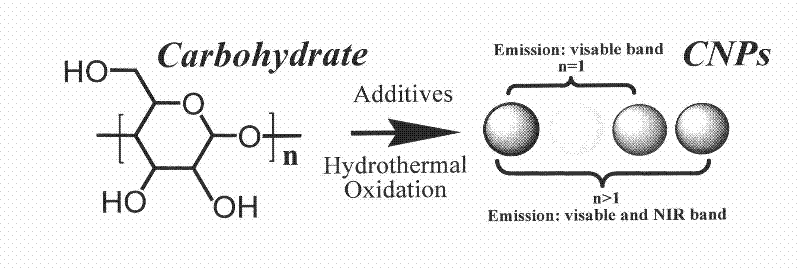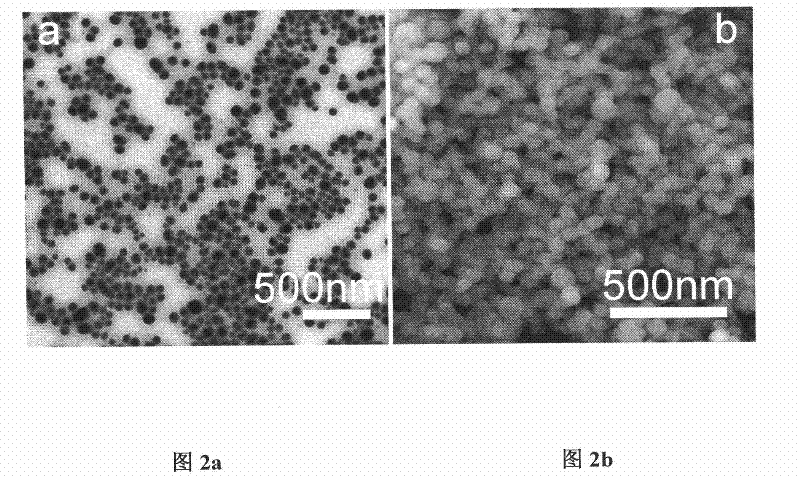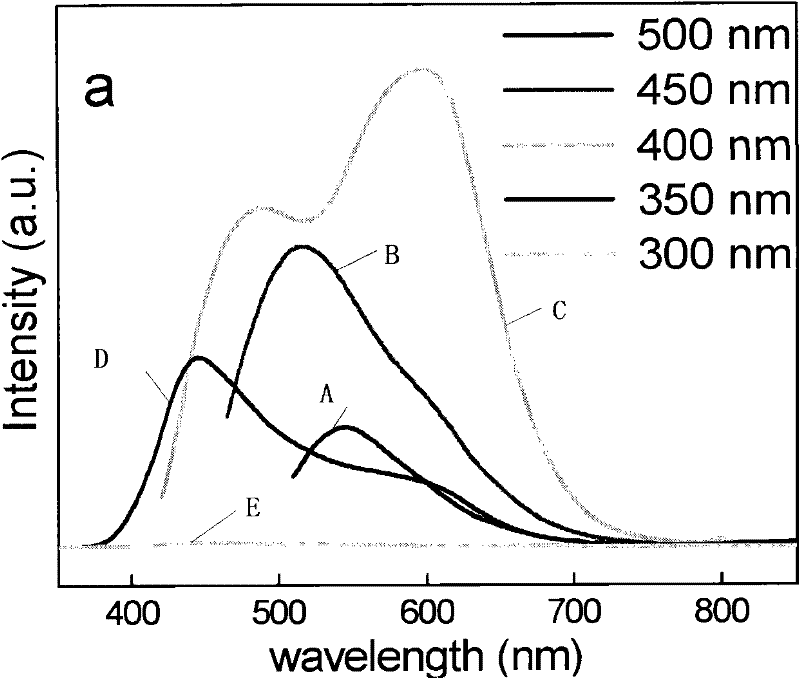Preparation method of carbon nanoparticle with controllable photoluminescence
A technology of carbon nanoparticles and photoluminescence, which is applied in the field of nanomaterials, can solve the problems of low quantum yield, single luminescence of photoluminescent materials, and easy photobleaching, etc., and achieve the effect of good dispersion
- Summary
- Abstract
- Description
- Claims
- Application Information
AI Technical Summary
Problems solved by technology
Method used
Image
Examples
Embodiment 1
[0030] In the preparation method of the present invention, 1g of glucose and 0.1g of sodium hydroxide are added to 15mL of deionized water, fully dissolved and stirred evenly, and prepared into a solution, added to a 20mL polytetrafluoroethylene jar, and then put into Stainless steel water heating kettle. The reaction was heated in an electronic oven at 160°C for 4 hours. The solution obtained after the reaction was separated by centrifugation, and the obtained precipitate was washed with water and ethanol three times each, then recrystallized to remove salt, put in a vacuum drying oven, and dried at 60°C for four hours to obtain a luminosity controllable Luminescent carbon nanoparticles. As shown in Figure 2, the obtained carbon nanoparticles have uniform morphology. Fluorescent properties were tested by fluorescence spectrophotometer, Figure 3a It is the ultraviolet-visible excitation-visible emission fluorescence spectrograms with excitation wavelengths of 500nm, 450nm,...
Embodiment 2
[0032] According to the method of the above-mentioned Example 1, only the type of the oxidation additive is changed, the carbohydrate is still glucose, and the oxidation additive is hydrochloric acid, and carbon nanoparticles with adjustable photoluminescent properties are prepared. Fluorescent properties were tested by fluorescence spectrophotometer, Figure 3b It is the ultraviolet-visible excitation-visible emission fluorescence spectrograms with excitation wavelengths of 500nm, 450nm, 400nm, 350nm, and 300nm, in which curves A, B, C, D, and E represent fluorescence at excitation wavelengths of 500nm, 450nm, 400nm, 350nm, and 300nm Spectrum; Figure 4b are the up-converted fluorescence spectra when the excitation wavelengths are 800nm, 850nm, and 900nm respectively, where curves F, G, and H represent the fluorescence spectra when the excitation wavelengths are 900nm, 850nm, and 800nm. It can be seen from the above spectra that the prepared carbon nanoparticles have ultravi...
Embodiment 3
[0034] According to the method of the above-mentioned Example 1, only the type of carbohydrate is changed, the carbohydrate is sucrose, and the oxidation additive is still sodium hydroxide, and carbon nanoparticles with tunable photoluminescent properties are prepared. Fluorescent properties were tested by fluorescence spectrophotometer, Figure 3c It is the ultraviolet-visible excitation-visible emission fluorescence spectrograms with excitation wavelengths of 500nm, 450nm, 400nm, 350nm, and 300nm, in which curves A, B, C, D, and E represent fluorescence at excitation wavelengths of 500nm, 450nm, 400nm, 350nm, and 300nm Spectrum; Figure 4c are the up-conversion fluorescence spectrum diagrams when the excitation wavelengths are 800nm, 850nm, and 900nm respectively, wherein curves F, G, and H represent the fluorescence spectrum diagrams when the excitation wavelengths are 900nm, 850nm, and 800nm; Figure 5a It is the near-infrared excitation and near-infrared emission fluores...
PUM
 Login to View More
Login to View More Abstract
Description
Claims
Application Information
 Login to View More
Login to View More - R&D
- Intellectual Property
- Life Sciences
- Materials
- Tech Scout
- Unparalleled Data Quality
- Higher Quality Content
- 60% Fewer Hallucinations
Browse by: Latest US Patents, China's latest patents, Technical Efficacy Thesaurus, Application Domain, Technology Topic, Popular Technical Reports.
© 2025 PatSnap. All rights reserved.Legal|Privacy policy|Modern Slavery Act Transparency Statement|Sitemap|About US| Contact US: help@patsnap.com



